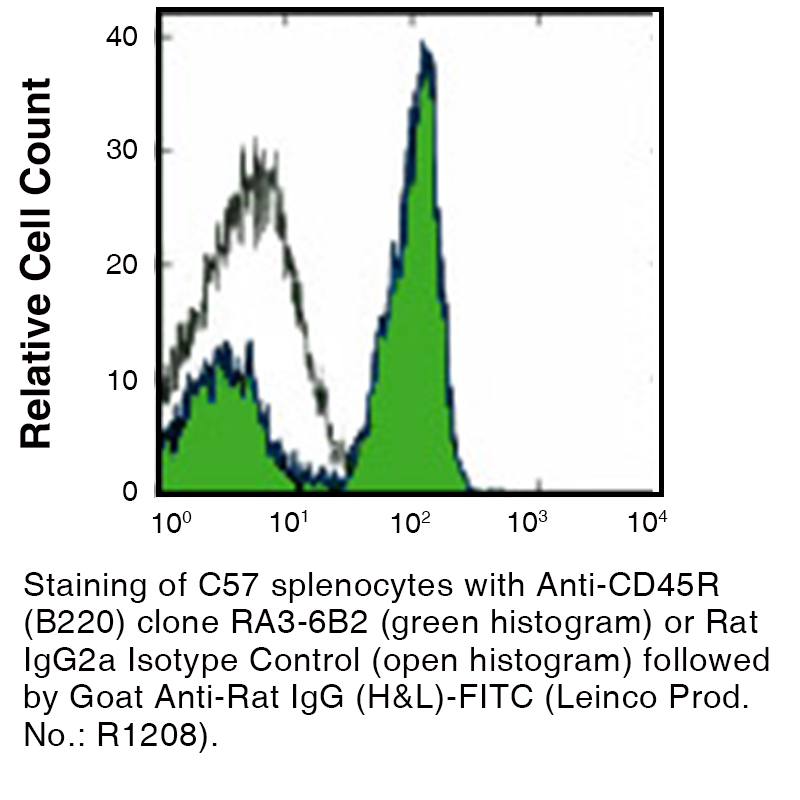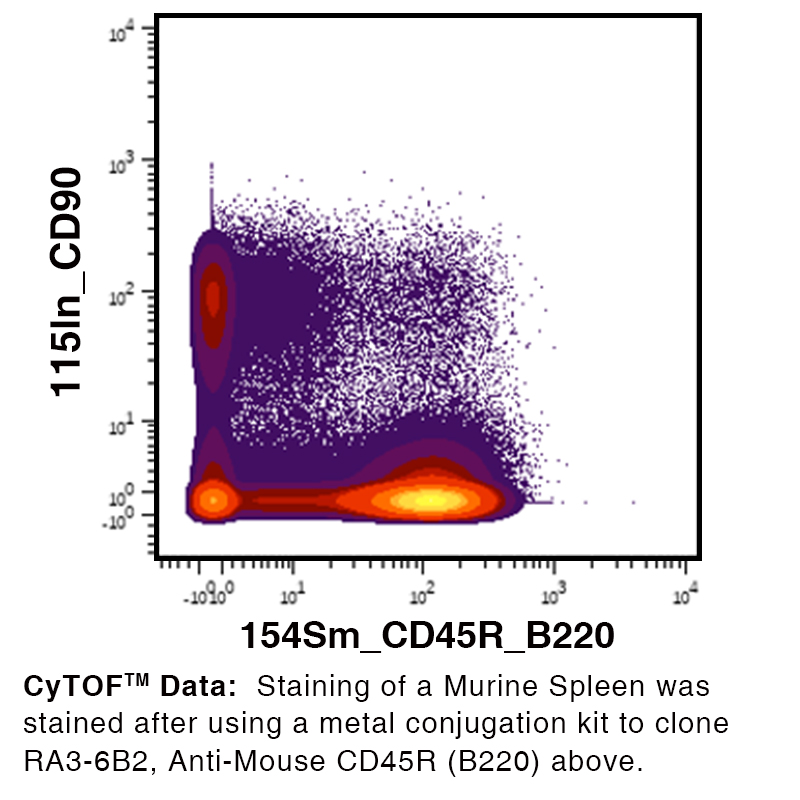Anti-Mouse/Human CD45R (Clone RA3-6B2) – Purified in vivo PLATINUM™ Functional Grade
Anti-Mouse/Human CD45R (Clone RA3-6B2) – Purified in vivo PLATINUM™ Functional Grade
Product No.: C2844
Clone RA3-6B2 Target CD45R Formats AvailableView All Product Type Monoclonal Antibody Alternate Names B220 Isotype Rat IgG2a κ Applications Act , CyTOF® , Depletion , FA , FC , IHC FF , in vivo , IP , PhenoCycler® |
Data
Antibody DetailsProduct DetailsReactive Species Human ⋅ Mouse Host Species Rat Recommended Isotype Controls Recommended Isotype Controls Recommended Dilution Buffer Immunogen Abelson murine leukemia virus-induced pre-B tumor cells Product Concentration ≥ 5.0 mg/ml Endotoxin Level <0.5 EU/mg as determined by the LAL method Purity ≥98% monomer by analytical SEC ⋅ >95% by SDS Page Formulation This monoclonal antibody is aseptically packaged and formulated in 0.01 M phosphate buffered saline (150 mM NaCl) PBS pH 7.2 - 7.4 with no carrier protein, potassium, calcium or preservatives added. Due to inherent biochemical properties of antibodies, certain products may be prone to precipitation over time. Precipitation may be removed by aseptic centrifugation and/or filtration. Product Preparation Functional grade preclinical antibodies are manufactured in an animal free facility using in vitro cell culture techniques and are purified by a multi-step process including the use of protein A or G to assure extremely low levels of endotoxins, leachable protein A or aggregates. Pathogen Testing To protect mouse colonies from infection by pathogens and to assure that experimental preclinical data is not affected by such pathogens, all of Leinco’s Purified Functional PLATINUM™ antibodies are tested and guaranteed to be negative for all pathogens in the IDEXX IMPACT I Mouse Profile. Storage and Handling Functional grade preclinical antibodies may be stored sterile as received at 2-8°C for up to one month. For longer term storage, aseptically aliquot in working volumes without diluting and store at ≤ -70°C. Avoid Repeated Freeze Thaw Cycles. Country of Origin USA Shipping Next Day 2-8°C RRIDAB_2829600 Applications and Recommended Usage? Quality Tested by Leinco FC The suggested concentration for this RA3-6B2 antibody for staining cells in flow cytometry is ≤ 0.25 μg per 106 cells in a volume of 100 μl. Titration of the reagent is recommended for optimal performance for each application. Additional Applications Reported In Literature ? Act PhenoCycler-Fusion (CODEX)® CyTOF® Depletion FA IHC (Frozen) Each investigator should determine their own optimal working dilution for specific applications. See directions on lot specific datasheets, as information may periodically change. DescriptionDescriptionSpecificity Clone RA3-6B2 recognizes the B-cell determinant (Mr 220 kD) of the CD45 molecule. Background CD45 is a 180-240kD glycoprotein member of the protein tyrosine phosphatase (PTP) family known for its involvement in regulating a variety of cellular processes including cell growth, differentiation, mitotic cycle, and oncogenic transformation. CD45 and its isoforms are vital regulators of T- and B-cell antigen receptor signaling. CD45 functions through its extracellular domain or through its cytoplasmic domain, and serves as a negative regulator of cytokine receptor signaling via JAK kinase supression. The large extracellular domain is highly glycosylated, and its multiple isoforms allow extensive variation in the structure of its side chains. CD45 isoforms show cell-type and differentiation-stage specific expression that can be used as markers that identify and distinguish between different types of immune cells. CD45R is an isoform of CD45 with a molecular weight of 220 kD. CD45R contains all three possible exons (A, B, and C); making it the longest protein generated from alternative splicing with a migration at 200 kD when isolated from T cells. Furthermore, B cells express CD45R with heavier glycosylation, bringing the molecular weight to 220 kD, hence the name B220. Notably, B220 expression is not only restricted to B cells and may also be expressed on activated T cells, on a subset of dendritic cells, and on other antigen-presenting cells. Additionally, activated and memory T lymphocytes express CD45RO which facilitates T cell activation. CD45RO lacks all three possible exons (A, B, and C), making it the shortest CD45 isoform. Antigen Distribution The CD45R antigen is present on mouse B-cells, B-cell precursors and lytically active subsets of lymphokine-activated killer cells (NK cells and non-MHC restricted CTL). Ligand/Receptor Galectin-1, CD2, CD3, CD4 PubMed UniProt.org Research Area Cell Biology . Immunology . Inhibitory Molecules . Neuroscience . Neuroscience Cell Markers Leinco Antibody AdvisorPowered by AI: AI is experimental and still learning how to provide the best assistance. It may occasionally generate incorrect or incomplete responses. Please do not rely solely on its recommendations when making purchasing decisions or designing experiments. Clone RA3-6B2 is commonly used in vivo in mice for B cell depletion and immunomodulation, making it a critical tool in experimental studies of B cell function and immune regulation. Key in vivo applications include:
In summary, RA3-6B2’s principal in vivo uses are B cell depletion, immunomodulation, and elucidation of B cell function in experimental mouse models. These applications are critical for understanding the roles of B cells in health and disease, and for preclinical testing of immune interventions. In the literature, the RA3-6B2 antibody, which targets CD45R/B220, is commonly used in combination with other antibodies to profile immune cell populations comprehensively. Some of the other commonly used antibodies or proteins used with RA3-6B2 include:
These antibodies are typically used in flow cytometric analysis, immunohistochemistry, and other immunological techniques to study immune cell subsets and their functions. The RA3-6B2 clone is a monoclonal antibody that specifically targets the CD45R/B220 isoform of the CD45 glycoprotein. It is widely used in scientific research as a marker for B cells and certain subsets of T cells and NK cells. Here are some key findings from citations involving the RA3-6B2 clone in scientific literature: Key Findings
These findings highlight the RA3-6B2 clone's utility in immunological research, particularly for studying B cell development and function. Dosing regimens for clone RA3-6B2 (anti-mouse CD45R/B220 monoclonal antibody) vary primarily by application (e.g., flow cytometry, immunohistochemistry, in vivo depletion), tissue target, and mouse model, rather than by a standardized dose per strain or disease model. Key details for common applications:
Mouse Model-Specific Considerations:
General Guidance:
In summary, dosing regimens of clone RA3-6B2 depend on the mouse model’s biology and experimental application, requiring empirical titration and adjustment in every context. References & Citations1. Coffman, B. et al. (1982) Immunological Rev. 69:5 2. Zuhair, K. et al. (1993) J. Immunol. 150:17 3. Asensi, V. et al. (1989) Immunology 68:204 Technical ProtocolsCertificate of Analysis |
Formats Available
Prod No. | Description |
|---|---|
C259 | |
C260 | |
C261 | |
C351 | |
C262 | |
C1943 | |
C1945 | |
C1947 | |
C517 | |
C383 | |
C2844 |
 Products are for research use only. Not for use in diagnostic or therapeutic procedures.
Products are for research use only. Not for use in diagnostic or therapeutic procedures.




